Apple and Samsung are old hands at it, Xiaomi and Realme are strong in the affordable segment, brands like Motorola and Nokia are relatively new, while OPPO is among the most recent entrants. I’m talking about the tablet segment of course, a category that continues to surprise. It did see significant uptake in the last 2-3 years, but I’m not sure if more growth can be expected in the very near future. Regardless, OnePlus feels it’s time to make a foray into this arena, and the result is the aptly-named OnePlus Pad, the brand’s first slate. Right off the bat, it seems like the brand is trying to follow the same strategy it did when it first came into the limelight — offering premium devices at comparatively lower price points. The OnePlus Pad’s flagship specs, premium build and the ~40k sticker price certainly point in this direction. Read on for my OnePlus Pad review to see how it fares.
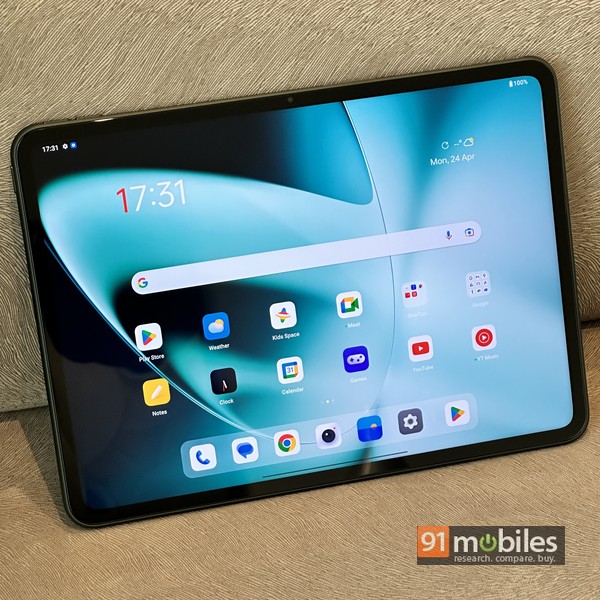
Design and display
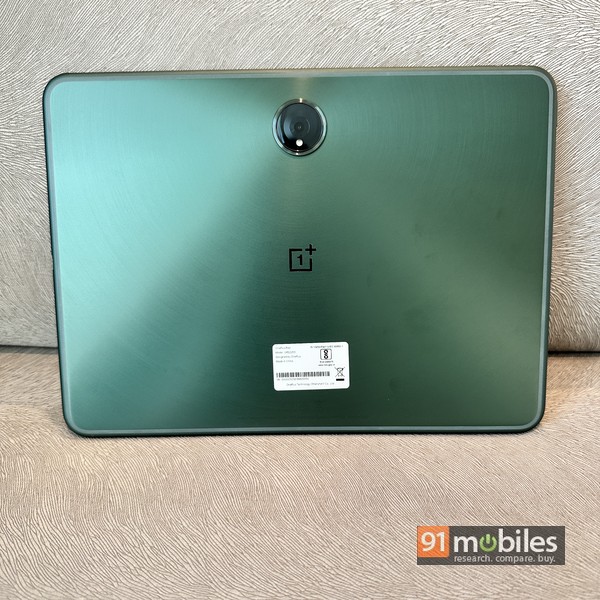
It doesn’t take more than a couple of minutes to realise OnePlus has left no stone unturned when it comes to the design and build quality — this slate is dressed to impress. The sleek “Halo Green” metal unibody with 2.5D curved edges, concentric circle pattern on the back, centre-aligned camera lens, and slim bezels around the large 11.61-inch display, all do their bit and ensure the tablet exudes class and screams premium. The device is quite slim, being just 0.65cm thick, and weighs 552g — about half a kg.
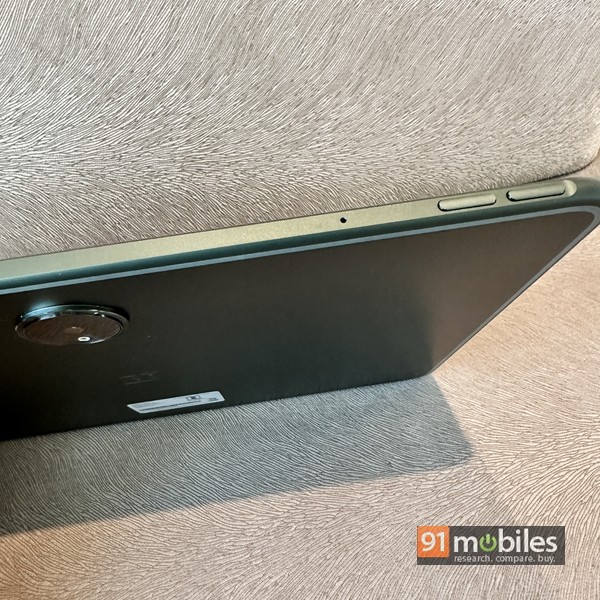
The top edge of the tablet (when held in portrait mode) is flat and holds two separate volume keys on the left, and a strip where the optional stylus attaches magnetically. The power key is on the top left, while the USB Type-C port on the right. Both sides have a pair of slits for the speakers, while the bottom has three pogo pin connectors for attaching the optional keyboard cover. The rear holds the large camera lens that hides a 13MP sensor. The front snapper utilises an 8MP sensor, and is positioned in the middle above the display as usual.
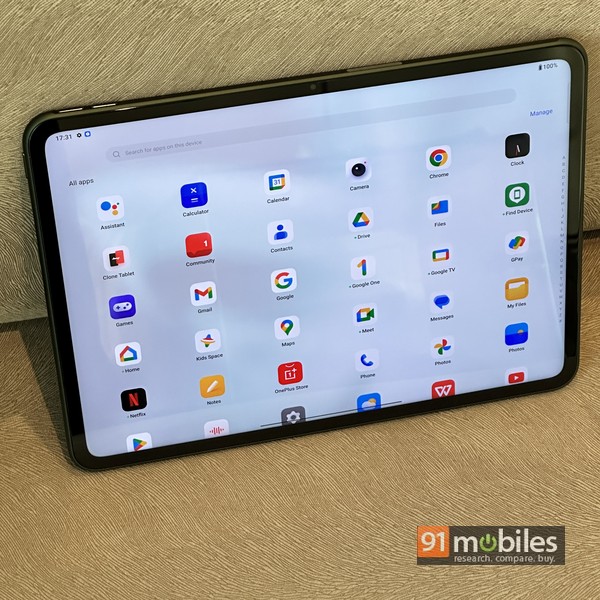
The 11.61-inch screen is of the LCD variety, offering a resolution 2,800 x 2,000 pixels. The unconventional 7:5 aspect ratio means it’s wider than others out there and as per OnePlus, makes it ideal for reading. Another segment first is the 144Hz refresh rate, which translates into smooth scrolling, and adjusts automatically between 30, 60, 90 and 120Hz according to different usage scenarios to save battery. Truthfully, you won’t find a massive difference as compared to another tablet with a 120Hz display, but it’s good to have nonetheless. Thanks to 500 nits of peak brightness, the OnePlus Pad’s display is quite bright and Dolby Vision support means it’s great for media consumption as well — supported video content looks pretty enjoyable with good dynamic range.
Software and ecosystem
The slate runs OxygenOS 13.1 atop Android 13, and the UI is close to stock for the most part. You even get Google Kids Space which lets you create separate user profiles for children, complete with age-appropriate content and apps. And barring Netflix. WPS Office, and 3-4 apps from OnePlus, there’s no bloatware here to mar the usage experience. There are no spammy notifications either, thank god. A few nifty additions from OnePlus are included, as can be expected. This includes OnePlus Shelf (a customisable panel you can populate using widgets) with smart suggestions by swiping downwards anywhere on the home screen, the ability to hide apps and protect them with a password (by swiping right in the app drawer), a smart sidebar where you can add your favourite apps for quick access, and more. A pre-installed Games app enables a special overlay that appears on top of games and gives you access to a few gaming-specific features, along with useful info such as fps, CPU / GPU utilisation etc. And then there are features that help you multitask and make the best use of the ample screen real estate. These include split screen which is activated using a two-finger downward swipe on the middle of the display for running two apps side by side. You can also open apps as floating windows that can be resized and dragged to any portion of the screen.
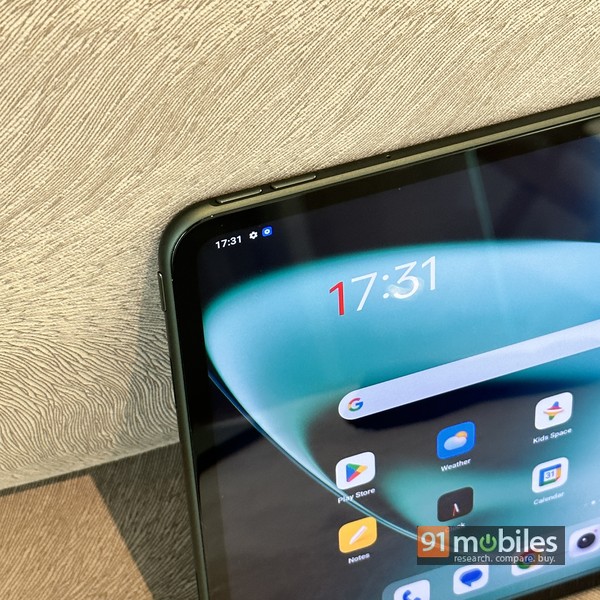
OnePlus has also included a few ecosystem features in the Pad, which isn’t surprising given how it has been following similar methodology in other segments like smartwatches and smart TVs as well. So if you have a OnePlus phone running OxygenOS 13.1 or later, it can connect automatically to the Pad, provided both devices are signed into the same OnePlus account. This enables features such as screen mirroring, content sync (which includes sharing clipboard content between the two devices and also synchronising media such as captured photos and videos), and app relay. There’s also a cellular data-sharing feature that lets the tablet access the internet using the paired phone’s connection. Ostensibly, this can work automatically and doesn’t really need setting up a Wi-Fi hotspot on the phone, which would be the more conventional way of doing this. I couldn’t try out these features myself as many of these are supposed to land via a software update on supported phones, expected in June. Also included is a nifty Notes app that includes drawing and voice-to-text, and cloud backup and sync features.
Keyboard and stylus
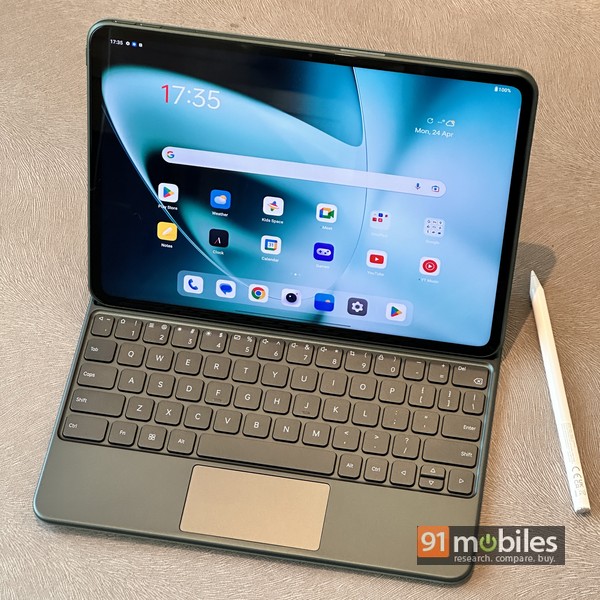
A tablet, especially one with a screen as big as the one on the OnePlus Pad, can handle work responsibilities as well. Sticking to convention, and rightly so, the tablet can make use of a keyboard cover and a stylus, both of which are optional purchases and sold as accessories by the brand. The keyboard, clad in a matching green hue and covered in premium faux leather, adds to the looks and premiumness of the device. Attaching magnetically to the pogo pin connectors on the base of the slate, the cover adds protection and also provides a kickstarting, apart from the ability to input text and control the tablet via its trackpad. Effectively converting the tablet into a mini laptop, the keys on the keyboard are nice to type on — the overall size is a bit cramped and needs a little getting used to, but otherwise, does come across as a useful accessory to have, The top row also enables shortcuts such as controlling volume and screen brightness, in conjunction with the function button. In addition, OnePlus also provides a bunch of keyboard shortcuts which you can use along with a special key located on the bottom row. It doesn’t look like these are customisable, but you can see the list of available shortcuts under keyboard settings. Again, it does involve a slight learning curve, but makes for a useful addition I think. The trackpad might be a bit small compared to the one on your laptop, but is quite smooth and responsive, and makes navigation and controlling the tablet a cinch.
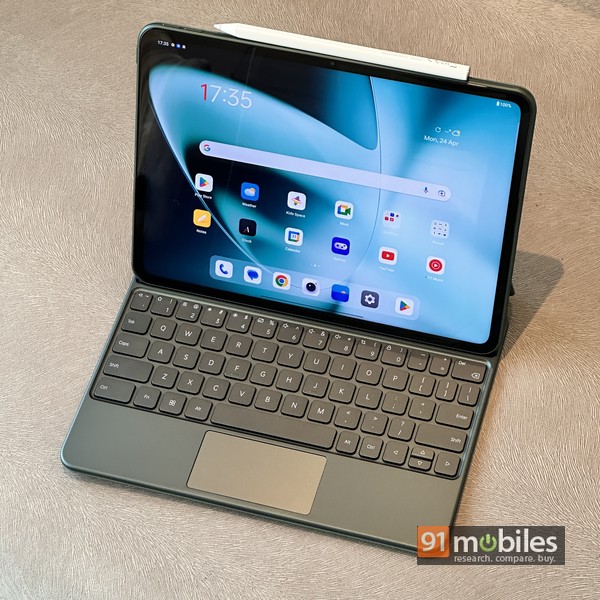
Then there’s the stylus, which is also an optional purchase. It bears the moniker OnePlus Stylo, and attaches magnetically to the strip on top of the tablet. Doing this juices up the stylus as well. The two devices talk to each other over Bluetooth, and the brand promises a low 2ms latency for smooth usage, along with support for 4,906 levels of pressure. The white appendage can be used along with the preloaded Notes app or any of the other supported third-party apps for doodling, note-taking and creative purposes. The Stylo offers a couple of useful features too. You can double tap on it to switch between the current tool and the eraser (this can be customised via settings). Also, double tapping the tablet’s display when it’s off using the Stylo opens up a quick note.
Performance, battery life and audio
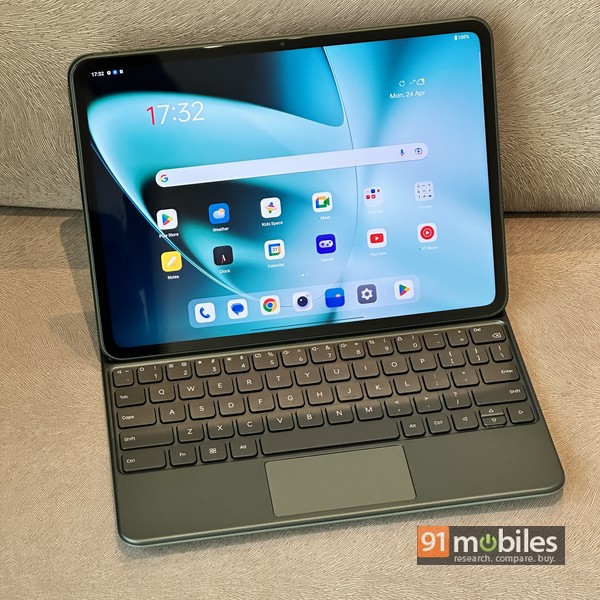
The OnePlus Pad makes use of MediaTek’s Dimensity 9000 SoC, which is a flagship-grade chip, previously seen in smartphones like the Vivo X80 and the OPPO Find N2 Flip. On the OnePlus Pad, this SoC is mated to either 8 or 12GB of RAM depending upon the variant you choose, giving you 128GB or 256GB of UFS 3.1 storage respectively. It’s a potent combination, resulting in smooth, lag-free performance for pretty much everything you do on the slate. The 9,510mAh battery is a performer as well, and with intermittent usage, can last multiple days depending upon how long you use the device for and the kind of apps you run. Even with extensive, heavy usage, you shouldn’t feel the need to charge it in the middle of the day. To top it off, the 67W SuperVOOC charging juices up the slate in just under an hour and a half. This is the fastest charging speed I’ve seen on a tablet so far, and needless to say, can be a boon since it significantly shortens the time your device needs to stay tethered to a wall socket. Audio quality is quite nice via the quad-speaker setup, so no complaints there. The 13MP rear and 8MP front snappers do their jobs as well. Also worth mentioning is that the tablet lacks a fingerprint sensor, but does come with a face unlock feature that works reasonably well, at least in good lighting conditions.
Verdict
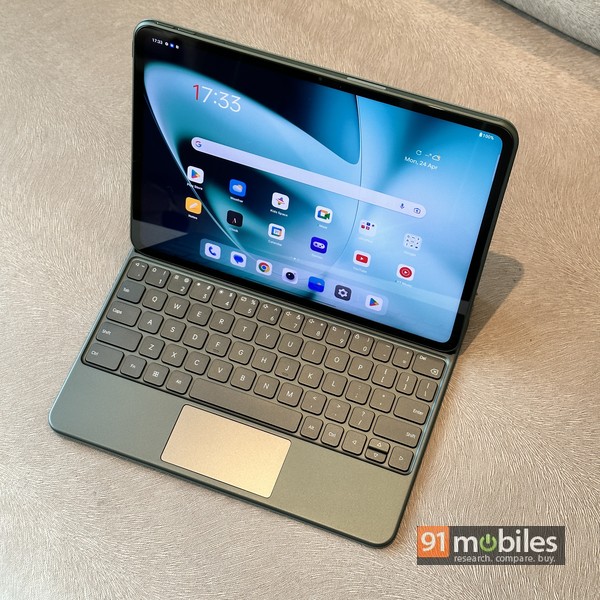
As I mentioned earlier, the OnePlus Pad sticks to the same ethos the brand’s devices have been known to follow — offering more for less. It’s a premium slate with flagship performance, and one that shines in almost all aspects. There’s no cellular option available, at least as of now, and while that might not appeal to many folks, does seem like a miss. A hotspot / data sharing is a quick and easy fix for that though. The tablet is priced at Rs 37,999 for the 8GB/128GB model and Rs 39,999 for the 12GB/256GB version, while the Stylo will cost you another Rs 4,999 and the keyboard cover Rs 7,999. While the stylus might not be useful for everyone, I think the keyboard cover does make for a useful addition, especially if you intend to use the device for work. The combo can be a useful companion while travelling, jumping between meetings handling work calls via Zoom / Google Meet, and thumping out emails etc. Not to mention the whole entertainment and content consumption angle — a use case where the OnePlus Pad shines as well. The Xiaomi Pad 5 (review) is a worthy contender, and cheaper by more than ~10k, but in its price segment, perhaps the closest rival for the OnePlus Pad would be the Apple iPad 10th-generation. Android vs iOS is a whole different story, and involves considering each platform’s strengths and weaknesses, along with figuring out to what extent you’ve invested into the OS. To be fair, iOS still seems to have more apps better suited for use on tablets, but it’s not everyone’s cup of tea. Moving back to the Android side of the fence, the OnePlus Pad should go up against premium options from Samsung and Lenovo, which are priced higher. All said and done, if you need a premium Android tablet for work and play, it’d be tough to beat the value proposition offered by the OnePlus Pad.
Editor’s rating: 4 / 5
Pros:
- Solid build, premium look & feel
- Nice screen
- Smooth performance
- Good battery life & fast charging
Cons:
- No cellular model
- Misses out on a fingerprint sensor
The post OnePlus Pad review: premium tablet done right first appeared on 91mobiles.com.
0 Comments